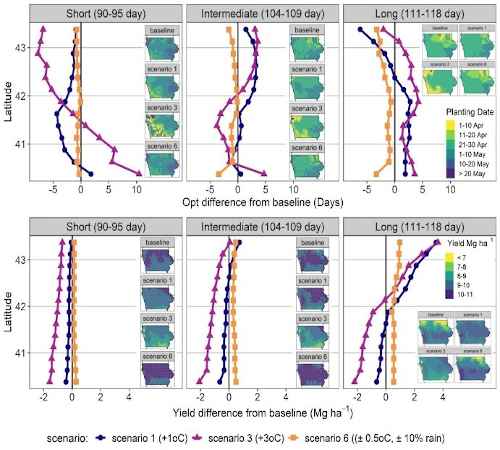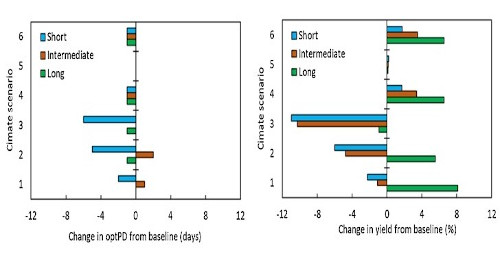By Mitchell Baum and Sotirios Archontoulis
Each year, decisions on planting date and cultivar selection are the major deciding factors on yield potential. Under current, year-to-year variable weather patterns and future climate change these decisions have become much more important. And there is a known knowledge gap on how future climate change will affect these decisions. In a recent paper, we explored future climate change impacts on planting date and cultivar selection using a robust crop model.
We used six climate scenarios to evaluate planting date and cultivar maturity selection:
- Baseline (1980-2015) + 1oC increase in minimum and maximum daily temperature
- Baseline + 2oC increase in minimum and maximum daily temperature
- Baseline + 3oC increase in minimum and maximum daily temperature
- Baseline + 0.5oC decrease in maximum and 0.5oC increase in minimum daily temperature
- Baseline + 10% increase in April-May and 10% decrease in July-Sept precipitation
- Combination of 4 and 5
Through regional scale simulations the optimum planting date advanced by 0.13 days per year, for 1980 to 2015. Climate change scenarios on average affected the optimum planting date by ± 5 days and the yield at the optimum planting date by ± 10%. Increasing daily minimum and maximum temperatures (scenarios 1 – 3) alone had an increasingly negative affect on corn yield. However, scenario 6, seemed to have relatively little effect on corn yield or optimum planting date.
The 36-yr average maize planting duration in Iowa is 44 days while it can as low as 21 days in some years that the weather was favorable. Shortening maize planting duration (beginning to end) could have substantial economic (up to $340 million per year additional revenue) and food security benefits.
Investments in planting technologies to accelerate planting in challenging weather years can be a direct response to upcoming climate volatility. Development of dynamic recommendations to inform farmers on the optimum planting dates and cultivar combination per year and location can also help mitigate impacts of increased climate variability.


Figure 1. Weather scenario impacts on optimum planting date (top panels) and yield (middle panels). The bottom panels represent statewide average impact per cultivar and scenario.
Source : iastate.edu